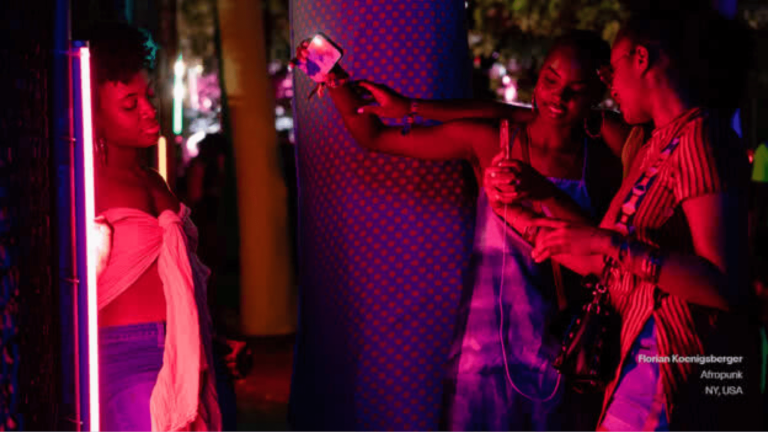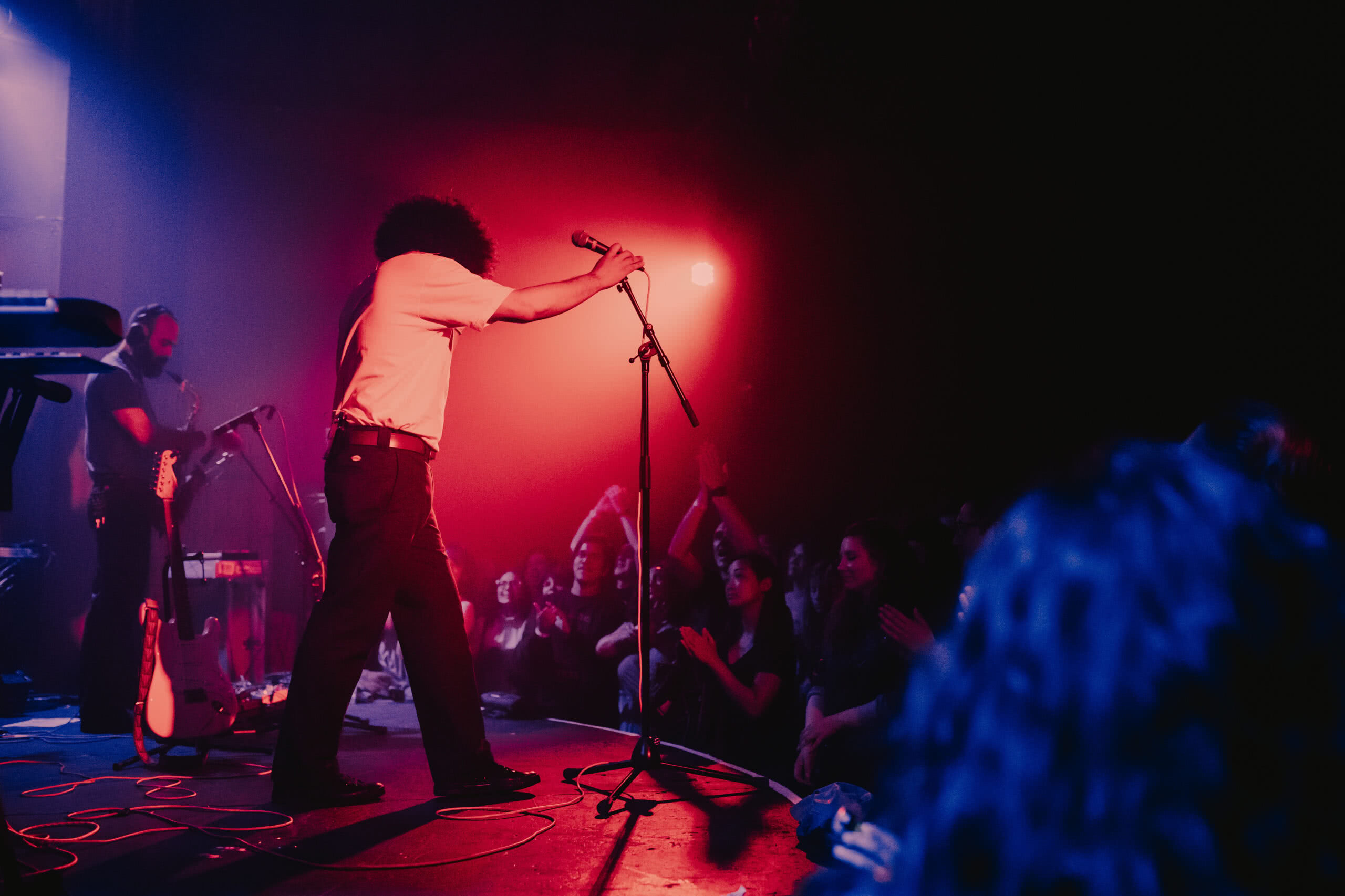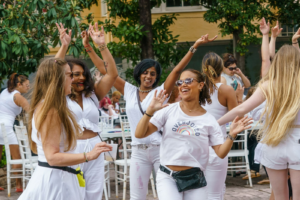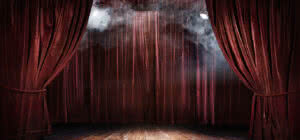It’s official: Immersive, experimental, and interactive events are in.
But audiences don’t want boring; they want fabulous. If you believe setting up a few lousy props will qualify as ‘fully immersive,’ think again.
To make a dent in this space, you must analyze and use what the best immersive experiences have in common. And that’s just what we’ve done.
Now, you’re probably thinking: ‘Eventbrite, how did you get so event-wise’? While flattered, we can’t take all the credit.
The truth is, we got the inside goss on immersive experiences from the experts. We surveyed awesome event organizers and attendees across the globe and put our findings into the TRNDS 2024 report.
In this article, we’ll show you how to create a fully immersive experience for attendees, plus some incredible real-world examples and ideas to inspire your next immersive event.

Okay, but what is an immersive experience?
An immersive experience is an out-of-this-world encounter that fully engages all five senses. It’s the ultimate form of ‘world-building’ that blurs the line between fiction and reality.
Immersive experiences typically use:
- Advanced technology: Incorporate devices like virtual reality or augmented reality
- Interactive storytelling techniques: Use live performers or actors to draw audiences into the experience
- Multi-sensory stimulation: Use sights, sounds, smells, and touch to make the experience feel more realistic
Immersive experiences are becoming increasingly popular with event organizers because guests want much more than a stock-standard agenda.
You need to create more than just a beautiful experience; rather, you need to create a collective experience that allows attendees to fully let go and temporarily leave ‘their physical self.’
Event organizers can build a wonderful experience using immersive art technology. For instance, artificial technologies are now used in educational events, like seminars, to promote immersive learning, and nightlife events are also jumping onto the virtual reality experience bandwagon.
But how do you offer attendees a ‘fully immersive’ event? Well, it really comes down to your event planning, venue design, and use of technology.
What makes an event a truly immersive experience?
A big mistake event organizers make is using the phrase ‘fully immersive experience’ in their event description to attract potential attendees when they’re not prepared to deliver on the promise.
If attendees arrive at your ‘fully immersive event’ only to find a few interactive elements, they’ll be disappointed.
Fully immersive experiences:
- Leverage spatial awareness technology and track participants’ movement to allow for dynamic interactions within the space
- Offer personalized journeys where attendees’ actions and choices shape the outcome of the experience
Let’s take a closer look to understand what an immersive experience is, and is not.
A truly immersive experience: Do’s and dont’s
A great example of a fully immersive event is the international Van Gogh immersive exhibit.
The event takes the spatial immersion element of a museum (low lighting and separation from the outside world) and amplifies it to an extraordinary level by:
✅ Pairing large screen projections with synchronized sound effects to create a multi-sensory experience
✅ Incorporating 3D elements to encourage audience participation
✅ Using dynamic lighting and set design to match different art pieces’ vibe, such as in the ‘starry night’ room where yellow lights make audiences feel they’re part of the painting
On the other hand, a not-so-great example of an immersive experience is the recent ‘Wonka disaster.’
The event promised attendees an enchanting journey into the world of chocolate but instead offered:
❌ No cohesive narrative, with actors performing awkwardly from incoherent, AI-written scripts
❌ No elaborate set decorations, lighting, or costume design that would help attendees feel ‘lost in the experience’’
❌ No separation from the ‘real world,’ with distractions like overflowing garbage cans and maintenance gear visible to all attendees
While the Wonka experience is an extreme case, it highlights the problem with advertising an event that fails to deliver.
Sub-par immersive events tend to introduce interactive features but fail to maintain consistent immersion throughout the entire event. So, although they still offer attendees moments of escapism, their lack of continuity doesn’t quite hit the mark of what an immersive experience should offer.
The best place to look for inspiration when it comes to creating fully immersive events is other event organizers testing the boundaries of reality.
How real event organizers make their events immersive
There are some truly outstanding pop-up immersive experiences in the US — one being Experiential at Refinery 29.
“We set out to create a physical manifestation of our brand — reflecting the topics our audience cares about most, our commitment to celebrating diverse creative voices, and the engagement we strive to ignite with brands and our audience.”
— Albie Hueston (Experiential at Refinery 29).
Let’s look at some of the best immersive experiences and see what they can teach us about creating life-changing events.
The Balloon Museum
The Balloon Museum turns attention to detail into an art form. Every space and element in the room is deliberately crafted to evoke specific emotions and transport attendees to another world.
For instance, the Karina Smigla-Bobinski ‘Hyperstudio’ installation features white walls from top to bottom and a floating balloon hanging in the middle of the room with pencil ends protruding from all sides — like a spiky moon.
Smigla-Bobinski encourages attendees to push, touch, and play with the ball and leave their mark on the walls around them.
💡Pro tip: The top lesson from The Balloon Museum is the importance of using a set and interactive elements at your event. Don’t be afraid to cover your space from floor to ceiling with interactive features that help build atmosphere and add to the emotional experience you’re creating.
Inter_
Inter_ is an interactive art experience in New York City that feels like a trippy portal into a world of neon lights and holographic images. It offers attendees a multi-sensory experience, paying particular attention to smell, taste, and touch.
Attendees can jump into puddles of light and watch them ripple like they would in real life or run their hands over interactive screens to make light particles scatter.
But what makes Inter_ one of the best immersive experiences we’ve seen is their strategic use of lighting. It would be easy for Inter_ to rely on their special effects to create an immersive experience, but instead, they use color theory to make each exhibit feel different.
For instance, their ‘meditation room’ is left in complete darkness, except for a soft red hue, which has an eerily hypnotic effect.
💡Pro tip: A standout strategy from Inter_ is how they create premium immersive experiences for VIP ticket buyers. For example, for their ‘High Vibrations’ adult-only event, a VIP ticket unlocks exclusive attractions on the day, such as their ‘terpene aroma testing.’
If you want to replicate this strategy, with Eventbrite you can easily create different event ticket types and pricing tiers, such as early-bird and VIP tickets.
Learn more about Eventbrite ticket tiers

SuperFun Land
Have you ever wondered what it’d be like to live inside a Kaleidoscope? Well, you can find out more about it by visiting Super Funland.
All the independent spaces at Super Funland beg attendees to let go and fully embrace their inner ‘super freak.’
From the ‘fortune teller siren’ carnival game that reacts when attendees insert their hand into the machine to the free-use stripper pole and 4D immersive ‘tunnel of love’ joyride, everything in Super Funland targets the attendees’ senses and creates an ‘untamed’ atmosphere.
There are so many things that Super Funland does exceptionally well to draw attendees into their world of depravity. But the one that stands out the most is their use of performative art.
We aren’t just referring to the seductive acrobats (although they’re breathtaking). Every team member fully embodies the theme, from their carnival costume to their demeanor; each team member adds another layer of realism to the experience.
💡Pro tip: Check out Super Funland’s Instagram to inspire you on how to use experiential marketing to sell your immersive experience to new attendees.
Super Funland encourages audiences to promote their brand for them on Instagram and TikTok. Their approach centers around creating raunchy and memorable attractions that attendees are eager to plaster all over their socials, resulting in more engagement and brand awareness by various audiences.

Immersive experience examples and ideas you can borrow for your next event
Now we’ve answered the question of ‘what is an immersive experience’ and looked at what the best immersive experiences offer, it’s time to move on to the main event: creating the best immersive experiences the world has ever seen.
Here are some immersive experience examples and ideas to get you started.
‘The night I went insane’: An immersive art experience
Effort: 🏋️ 🏋️ 🏋️
Cost: 💰💰
Fun factor: 🥳 🥳 🥳
For your next event, turn the horrifying ‘tunnel of terror’ from Willy Wonka into a disturbing and engaging pop-up immersive art experience.
Set up your venue to look like the inside of a dingy insane asylum, with treatment and patient rooms, low-hanging flickering lights, and green, slimy walls that morph and move when touched.
Put up medicine cabinets, and screen a holographic projection of a doctor prescribing attendees ‘happy pills’ and then reveal that — whoops — they’re actually poison.
In one of the treatment rooms, dress performance artists as nurses who tend to ‘patients’ by cradling them like babies and feeding them bright, glow-in-the-dark yellow goo. Use flashing red lights to create the illusion of danger, and use interactive technology so that when attendees touch certain objects, they’ll hear the sound of a baby crying.
💡Pro tip: To make this event even spookier, choose a venue with a creepy history, like GRIP does with their paranormal events.

‘Out of this world’: An immersive space journey
Effort: 🏋️ 🏋️ 🏋️
Cost: 💰💰💰
Fun factor: 🥳 🥳 🥳
What if instead of taking attendees to a new world, you take them to another planet?
Create a narrative-driven immersive experience where attendees become part of a secret space mission set up by the government to find a new planet called ‘Doom’ and save the human race.
To really sell the experience, set up your venue as a sequence of events.
Here’s what we mean: In the first exhibit, actors playing ‘government officials’ strap attendees into a make-shift ‘rocket ship’ (aka a row of old plane seats) while warning them of the dangers to come.
As the rocket ship takes off, project stars on the walls and floors, put a cloud of smoke underneath attendees’ feet at ‘take off,’ and use visual effects to make it seem like the rocket ship is flying through space at high speed.
The story will continue to evolve with every new interactive space attendees enter. For instance, you could build an anti-gravity space where attendees encounter a ‘live alien’ who reveals that planet ‘Doom’ is not what it seems.
💡Pro tip: Look into Angry Fish Theatre’s The Waiting Room event and how they utilize generative AI to create immersive projections and enhance the realism of their event.
‘Go, my little spider-monkey’: A digital experience
Effort: 🏋️ 🏋️
Cost: 💰💰
Fun factor: 🥳 🥳 🥳
The best immersive experiences open attendees’ eyes to new perspectives. So a digital experience that puts attendees in a monkey’s mind inside a magical forest would be an absolute hit.
To do this, hire an indoor venue and create an audio-guided journey through the jungle. If you need help nailing the vibe, just imagine Avatar but narrated by David Attenborough.
Rent a wind and rain machine to mimic the jungle’s changing weather, and set up different interactive spaces around the venue, such as a pond where attendees can try and catch a holographic fish with their bare hands.
Temple SF’s Immersive Ocean Flow event is an excellent example of using projections to give attendees an out-of-body experience.
Don’t be afraid to let your imagination run wild with the features inside the magical jungle. You could have a 4D unicorn run around the venue and place ‘pig-ferns’ (a plant that snorts when attendees touch it) on the floor.
💡Pro tip: For the more daring event organizers who want to take this immersive experience one step further, invest in an elevated platform and allow your monkey attendees to ‘take to the treetops.’

‘Welcome to the tribe’: A collective experience
Effort: 🏋️ 🏋️
Cost: 💰💰
Fun factor: 🥳 🥳
All the best immersive experiences feel like a fever dream, pushing attendees to question their sense of reality, memory, and logic.
Tap into attendees’ primal instincts by stripping them of their ‘modern ideologies’ and sending them back to the stone age. Invite attendees to dress in caveman costumes. You can also set up a raging bonfire in the middle of your venue (if it’s outdoors) and cover the entire floor with sand.
Then, collaborate with a local band and ask them to dress in lion heads and play tribal chants on peculiar instruments, like a drum made of human skulls.
During your event, use a blowhorn to introduce the ‘tribe leader’ (a paid actor) and have him explain to attendees that to make it into the tribe, they must survive a day and a night in the middle of the desert.
Use a flashing sign to encourage attendees to lie in the sand around them. This is when the event gets interesting.
Set up a projector screen on the roof to look like the ‘sky in the desert’ with a harsh spotlight mimicking the blazing hot sun. Once they lie down, use a crane to slowly inch the projector screen closer to them, turning up the heat in the room as you do.
The combination of the droning sounds, the rising heat of the ‘sun,’ and the feeling of sand between their toes and fingers will make attendees lose control over their spatial awareness and create the illusion that they’re in the desert.
💡Pro tip: Set up a bar in the venue where bartenders only communicate in grunts and gestures and serve drinks in coconuts and cups carved out of stone.
Remember that immersive experiences are meant to be experimental — so don’t limit yourself to the bounds of the ‘ordinary world.’ Flex your creative muscles and think up an entirely new reality that will leave attendees truly spellbound.

Are you ready to create an immersive experience?
The best immersive experiences build a whole new world for attendees and give them an emotional and physical experience they’ll remember for the rest of their lives.
Are you prepared to become the event magician your attendees need you to be? If so, then you’re ready to become an Eventbrite organizer.
Allow us to help you perfect your social media marketing, offer seamless (and secure) checkouts, and provide better live streaming to more immersive experiences.






